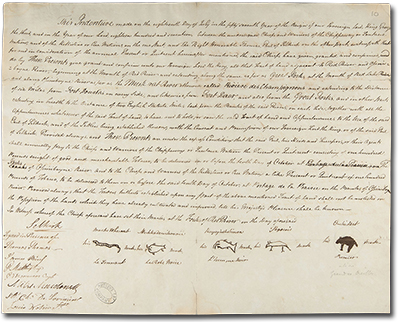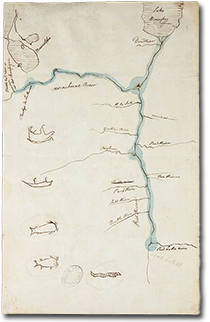Spotlight: HBCA in words and images
The Selkirk Treaty and Map
The Selkirk Treaty and map are part of a series of legal records relating to the Red River Settlement that were most likely acquired by the Archives Department of the Hudson's Bay Company from HBC's solicitors, Freshfields, Leese and Munn, in 1923.
In 1811, 116,000 square miles of land in what is now Manitoba was granted to one of HBC’s controlling stockholders, Thomas Douglas, the 5th Earl of Selkirk. Lord Selkirk was a Scottish nobleman who wished to settle displaced Highlanders, among others, on the fertile lands surrounding the confluence of the Red and Assiniboine Rivers. The Red River Settlement – the first European agricultural colony in Western Canada – was established the following year.
Transcript of the Selkirk Treaty (PDF)

enlarge image full size

enlarge image full size
In order to provide for the peaceful continuation of the settlement, Lord Selkirk and his representatives negotiated with Indigenous leaders in the area for possession or use of the land extending in two mile tracts along both sides of the Red and Assiniboine Rivers in exchange for an annual payment or gift.
On July 18, 1817, Lord Selkirk signed the treaty with 5 leaders referred to in the document as “Chiefs and Warriors of the Chippeaway or Sautaux Nation, and the Killistine or Cree Nation.” It has become widely known as the Selkirk Treaty. This is the first formal written agreement in Western Canada recognizing Indigenous land rights. It was superseded by Treaty I in 1871.
See past features in the Spotlight Archive.


